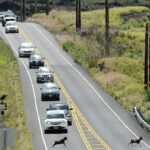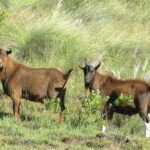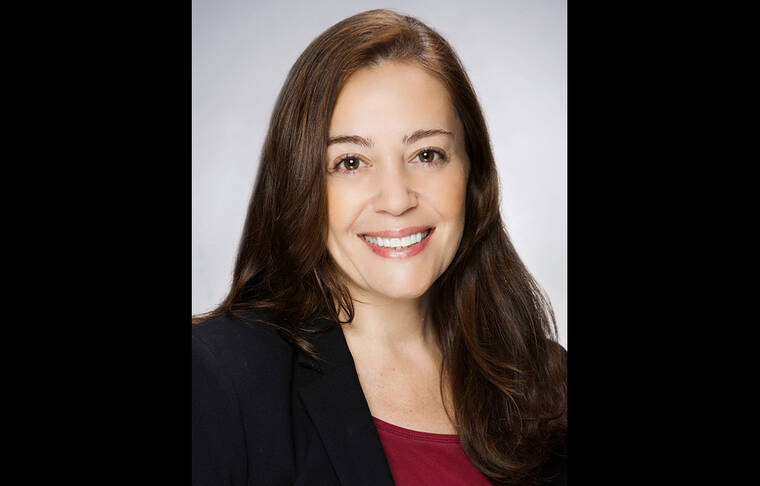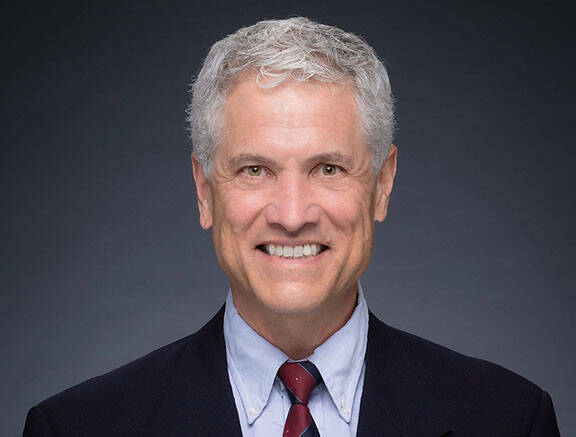As drought conditions continue in West Hawaii, state officials are searching for ways to mitigate the impacts of wild goats.
The invasive animals have been a perennial thorn in the side of West Hawaii residents, particularly drivers, who must be constantly vigilant to avoid the goats when they run across roads without warning. But as the drought worsens, the animals are seeking sustenance ever closer to developed areas, increasing the risk of deadly collisions.
“The goats are moving to more irrigated land,” said Kohala Rep. David Tarnas. “And with the runoff from the roads, the grass actually grows greener closer to the road, so the goats are coming in closer to the roads.”
According to the Hawaii Police Department, there have been eight reported goat-related car accidents on Highway 190 since the beginning of 2022, and 23 on Daniel K. Inouye Highway in the same time frame, although those are only the reported incidents.
“I live in Kona, and I drive back and forth over Saddle Road very often,” said resident Warren Chong. “And recently, I saw well over two dozen animal carcasses on the road … goats, sheep, pigs. … It’s not a good attraction for tourists.”
Tarnas said his office constantly receives complaints from constituents concerned about the animals, not just from drivers worried about a potential crash — although he said that is the most common worry — but from farmers frustrated by goats interfering with their crops.
Tarnas said that because of food safety standards, farmers sometimes have to throw away whole crops after goats get into them, a waste that many can scarcely afford.
Meanwhile, the goats’ voracious appetite has led to increased erosion concerns, as the animals denude the hills of grass that protects the soil from washing away.
A bill Tarnas wrote last year established a task force to develop a “feral ungulate management plan” comprised of various state and county stakeholders, including representatives from the Department of Land and Natural Resources, Hawaii Invasive Species Council, the Hawaii County Game Management Advisory Commission, and others.
Task force member Jason Omick, wildlife biologist with DLNR’s Division of Forestry and Wildlife, told the Tribune-Herald that the group is developing a draft guidance document proposing temporary rule changes that could help bring the goat population down to manageable numbers.
Some of those rules changes could be substantial. Omick suggested that a temporarily lengthened hunting season could expand the allotted time for archery hunting in the Puu Waawaa Forest Reserve from 16 to 89 days, and in the Puu Anahulu Game Management Area from 38 to 89 days. Muzzleloader seasons in each area could also be expanded to 52 days under the proposed rules — currently, the Puu Waawaa muzzleloader season is only 7 days, and no such season exists at all in Puu Anahulu.
“Anecdotally, other areas where public hunting has not been established have seen dramatic increases in goat numbers,” Omick said via email. “Most of these areas occur on private land where the state has no jurisdiction to establish public hunting regulations.”
The task force also has identified two stretches of highway as strong candidates for an extensive buildout of roadside fencing, which Omick stated would be the most effective method of keeping goats off the roads. One of those segments would be on Highway 190 between mile-markers 6 and 26, while the other would be on Daniel K. Inouye Highway between mile-marker 28 at the Maunakea Access Road and the Highway 190 intersection.
In addition, the task force has proposed the creation and maintenance of “a 10-meter zero-vegetation buffer along all highways,” along with the removal of grooved rumble strips along the sides of highways. Those grooved strips allow rainwater to pool and attract animals.
Omick did not say whether these suggested plans have any cost estimates to implement. However, both Tarnas and Kona Rep. Nicole Lowen said that extensive roadside fencing projects might not be infeasible.
“Fencing is expensive,” Tarnas said. “If a gap opens up anywhere, then the whole thing falls apart.”
Lowen suggested that eradication of the goats might be a simpler solution on paper, but added that it would be similarly unfeasible due to the impact on Big Island hunters.
Tarnas noted that even the hunting community considers goats to rank low on their list of desirable hunting targets, behind sheep and pigs.
“Goats aren’t their prime targets, so if we really pushed hard to reduce their numbers, I think they’d understand,” Tarnas said.
Tarnas said some of the task force’s proposals might turn into bills for future legislative sessions, but Lowen said there is only so much that lawmakers can do to address the issue.
“We can’t pass a law to outlaw goats,” Lowen said.
Omick pointed out DLNR’s limitations as well, saying via email that the state manages game mammals on state lands only. Issues on private lands remain outside the state’s jurisdiction, although private landowners are not legally prohibited from removing the animals from their property.
Omick also noted in his email that DOFAW employs “one (1) Wildlife Biologist and two (2) Forestry and Wildlife Technicians responsible for all wildlife issues for approx. 300,000 areas of public land and 1 million acres of private land in West Hawaii.”
Meanwhile, no organization or agency has even rough estimates for how many goats exist on the Big Island. Omick stated that DLNR has estimates for state public hunting areas only, extrapolated from camera traps and other sampling, which put the populations in Puu Waawaa and Puu Anahulu at about 2,150 in 2022.
But until any of the task force’s proposals become reality, drivers will have to remain vigilant.
“It’s getting to the point where if you’re driving Saddle Road at night, you should follow another car so they’ll hit the goats and not you,” Chong said, adding that hitting an animal is not only dangerous and a financial burden, but can be traumatizing as well.
“Something has to be done. To neglect this is irresponsible.”
Email Michael Brestovansky at mbrestovansky@hawaiitribune-herald.com.













